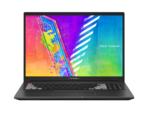Asus VivoBook Pro 16X N7600PC
Ausstattung / Datenblatt

Preisvergleich
Durchschnitt von 6 Bewertungen (aus 12 Tests)
Testberichte für das Asus VivoBook Pro 16X N7600PC
Quelle: Htxt Africa
 EN→DE
EN→DEWith prices as low as R24 999 for the iteration we tested, the ASUS Vivobook Pro 16X OLED is the perfect tool for creators on the go or those just starting out. While we have tested notebooks that outperform this notebook, from our own experience using the Vivobook Pro 16X OLED for content creation, it’s fantastic especially for the use cases above. We don’t like the 4K display because as we’ve lamented in the past, 4K on a 16inch display such as this means the minute details are lost on you unless you’re inches from the display. Other than that, the battery life is in line with other notebooks with this spec, the performance is decent and we really can’t find fault here. We can absolutely give the ASUS Vivobook Pro 16X OLED a recommendation for those looking to be more productive while away from their primary editing station or those looking to start editing video and the like. Great job ASUS, we’re sad we have to give this notebook back.
Einzeltest, online verfügbar, Mittel, Datum: 23.03.2022
Bewertung: Gesamt: 80%
Quelle: Laptop Media

Einzeltest, online verfügbar, Kurz, Datum: 18.03.2022
Quelle: Laptop Media
 EN→DE Archive.org version
EN→DE Archive.org versionUsually, pairing a performance-related product with a Tiger Lake H35 CPU isn’t the best idea. The main reason for that is the low core count. Capped at four cores, they just can’t deliver the raw power of their H45 counterparts, or AMD’s Zen 3 laptop lineup. On the other hand, you get a package, that is slightly easier to cool, and is just sipping of the battery. This results in more than 17 hours and a half of Web browsing on a single charge – a huge result from the VivoBook Pro 16X. Ultimately, this is not only due to the efficiency of the processor but also because of the large 96Wh battery pack. Although ASUS is playing it a bit safe with this notebook, we actually feel pretty comfortable about it. If you are going to need it mostly for processor-intensive work, go for the AMD version, otherwise, the Intel one will suit you great. Of course, keep the memory situation in mind, and if possible skip the base 8GB option.
Einzeltest, online verfügbar, Sehr Lang, Datum: 17.12.2021
Quelle: Laptop Media
 Archive.org version
Archive.org versionSupport, online verfügbar, Kurz, Datum: 05.12.2021
Quelle: Root Nation
 EN→DE Archive.org version
EN→DE Archive.org versionWithout a doubt, the ASUS Vivobook Pro 16X OLED (N7600) is a very good laptop. It has an original design, but the main thing about is a stunning OLED display. I want to look at it and use it, especially because of other features that are implemented here at a fairly high level. Decent sound of the speakers, very comfortable keyboard and a large touchpad with a virtual DialPad interface – there’s a lot going for it. So, overall, this is a great machine for working with media content on the go. But if your tasks require as many processor cores in a laptop as possible, you should take a look at the Vivobook Pro 16X OLED based on AMD Ryzen processors, which are labeled with the M7600 prefix.
Einzeltest, online verfügbar, Sehr Lang, Datum: 11.11.2021
Quelle: Ultrabook Review
 EN→DE Archive.org version
EN→DE Archive.org versionThis VivoBook Pro 16X N7600 series could have been a much better-balanced product if Asus opted for Tiger Lake H45 6C/8C hardware over the H35 4C processors they went with instead. As it is, I feel that potential creators looking for this sort of mid-range work laptop would get better value with the AMD-based Ryzen 45 versions of the Pro 16X when those will be available in stores, as they offer the same ergonomics, construction, features, OLED screen, and big-battery, but in a hardware implementation that's better suited for the performance needs of modern creators these days.
Einzeltest, online verfügbar, Sehr Lang, Datum: 26.10.2021
Bewertung: Gesamt: 80%
Quelle: Mi Mundo Gadget
 ES→DE
ES→DEPositive: Big screen; powerful processor; great dedicated graphics card; fast fingerprint sensor. Negative: Poor display; non-expandable RAM.
Einzeltest, online verfügbar, Mittel, Datum: 08.04.2022
Quelle: Tweakers
 NL→DE
NL→DEUser-Test, online verfügbar, Kurz, Datum: 16.04.2022
Bewertung: Gesamt: 60%
Quelle: Clubic
 FR→DE
FR→DEEinzeltest, online verfügbar, Lang, Datum: 15.04.2022
Bewertung: Gesamt: 80% Preis: 80% Leistung: 70% Mobilität: 80% Gehäuse: 80%
Quelle: Presse Citron
 FR→DE
FR→DEEinzeltest, online verfügbar, Mittel, Datum: 13.02.2022
Bewertung: Gesamt: 86% Preis: 90% Leistung: 80% Bildschirm: 95% Mobilität: 75% Gehäuse: 90% Ergonomie: 90%
Quelle: Phonandroid
 FR→DE Archive.org version
FR→DE Archive.org versionEinzeltest, online verfügbar, Lang, Datum: 17.11.2021
Bewertung: Gesamt: 80%
Quelle: Jagat Review
 ID→DE
ID→DEPositive: Stylish design; high performance; great dedicated graphics; fast SSD; big screen; excellent display; comfortable keyboard; long battery life; high security; good connectivity. Negative: Non-expandable RAM; overheats while using; weak connectivity.
Einzeltest, online verfügbar, Sehr Lang, Datum: 25.02.2022
Kommentar
NVIDIA GeForce RTX 3050 4GB Laptop GPU: Mobile Gaming-Grafikkarte die wahrscheinlich auf den GA107 Chip basiert. Bietet 2048 GPU Kerne und ist in verschiedenen TGP Varianten von 35 - 80 Watt erhältlich. Je nach Variante kann die Leistung deutlich variieren, da auch die Taktraten unterschiedlich ausfallen. Ältere Version mit 4 GB VRAM.
Diese Klasse ist noch durchaus fähig neueste Spiele flüssig darzustellen, nur nicht mehr mit allen Details und in hohen Auflösungen. Besonders anspruchsvolle Spiele laufen nur in minimalen Detailstufen, wodurch die grafische Qualität oft deutlich leidet. Diese Klasse ist nur noch für Gelegenheitsspieler empfehlenswert. Der Stromverbrauch von modernen Grafikkarten in dieser Klasse ist dafür geringer und erlaubt auch bessere Akkulaufzeiten.
» Weitere Informationen gibt es in unserem Notebook-Grafikkartenvergleich und der Benchmarkliste.
i7-11370H: Auf der Tiger-Lake-Architektur basierender ULV-SoC (System-on-a-Chip) für schlanke Notebooks und Ultrabooks. Integriert unter anderem vier CPU-Kerne mit 3 - 4,8 GHz und HyperThreading sowie eine starke G7 Grafikeinheit und wird in 10-Nanometer-Technik gefertigt (10nm SuperFin). » Weitere Infos gibt es in unserem Prozessorvergleich Vergleich mobiler Prozessoren und der Prozessoren Benchmarkliste .



